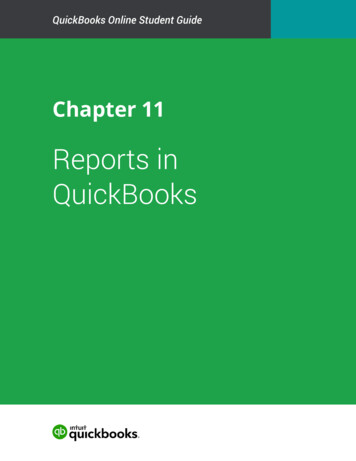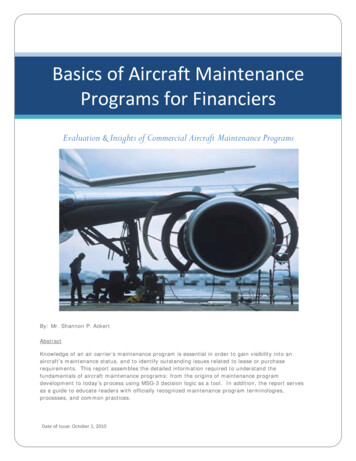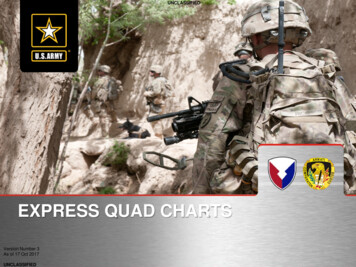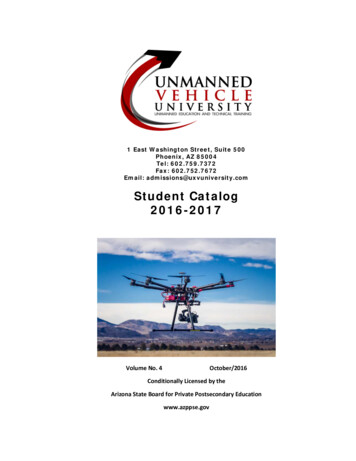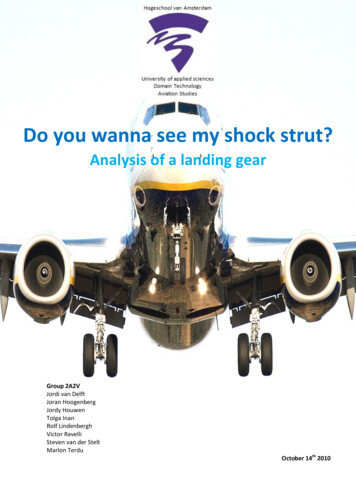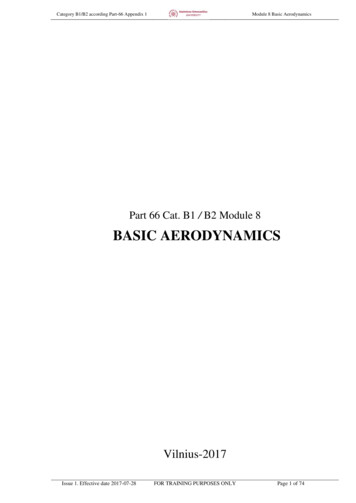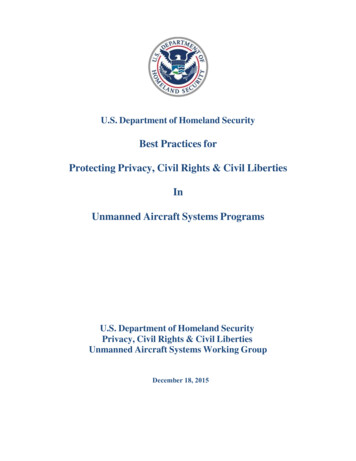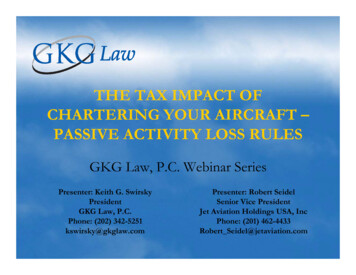
Transcription
ASRS Database Report SetUnmanned Aircraft Systems (UAS) ReportsReport Set Description .Reports involving Unmanned Aircraft Systems (UAS)events reported by operators of manned or unmannedaircraft.Update Number .14Date of Update .November 17, 2021Number of Records in Report Set .50Records within this Report Set have been screened to assure their relevance to the topic.
National Aeronautics andSpace AdministrationAmes Research CenterMoffett Field, CA 94035-1000TH: 262-7MEMORANDUM FOR: Recipients of Aviation Safety Reporting System DataSUBJECT: Data Derived from ASRS ReportsThe attached material is furnished pursuant to a request for data from the NASA Aviation SafetyReporting System (ASRS). Recipients of this material are reminded when evaluating these dataof the following points.ASRS reports are submitted voluntarily. The existence in the ASRS database of reportsconcerning a specific topic cannot, therefore, be used to infer the prevalence of that problemwithin the National Airspace System.Information contained in reports submitted to ASRS may be amplified by further contact withthe individual who submitted them, but the information provided by the reporter is notinvestigated further. Such information represents the perspective of the specific individual who isdescribing their experience and perception of a safety related event.After preliminary processing, all ASRS reports are de-identified and the identity of the individualwho submitted the report is permanently eliminated. All ASRS report processing systems aredesigned to protect identifying information submitted by reporters; including names, companyaffiliations, and specific times of incident occurrence. After a report has been de-identified, anyverification of information submitted to ASRS would be limited.The National Aeronautics and Space Administration and its ASRS current contractor, BoozAllen Hamilton, specifically disclaim any responsibility for any interpretation which may bemade by others of any material or data furnished by NASA in response to queries of the ASRSdatabase and related materials.Becky L. Hooey, DirectorNASA Aviation Safety Reporting System
CAVEAT REGARDING USE OF ASRS DATACertain caveats apply to the use of ASRS data. All ASRS reports are voluntarily submitted, andthus cannot be considered a measured random sample of the full population of like events. Forexample, we receive several thousand altitude deviation reports each year. This number maycomprise over half of all the altitude deviations that occur, or it may be just a small fraction oftotal occurrences.Moreover, not all pilots, controllers, mechanics, flight attendants, dispatchers or otherparticipants in the aviation system are equally aware of the ASRS or may be equally willing toreport. Thus, the data can reflect reporting biases. These biases, which are not fully known ormeasurable, may influence ASRS information. A safety problem such as near midair collisions(NMACs) may appear to be more highly concentrated in area “A” than area “B” simply becausethe airmen who operate in area “A” are more aware of the ASRS program and more inclined toreport should an NMAC occur. Any type of subjective, voluntary reporting will have theselimitations related to quantitative statistical analysis.One thing that can be known from ASRS data is that the number of reports received concerningspecific event types represents the lower measure of the true number of such events that areoccurring. For example, if ASRS receives 881 reports of track deviations in 2010 (this number ispurely hypothetical), then it can be known with some certainty that at least 881 such events haveoccurred in 2010. With these statistical limitations in mind, we believe that the real power ofASRS data is the qualitative information contained in report narratives. The pilots,controllers, and others who report tell us about aviation safety incidents and situations in detail –explaining what happened, and more importantly, why it happened. Using report narrativeseffectively requires an extra measure of study, but the knowledge derived is well worth the addedeffort.
Report Synopses
ACN: 1824677(1 of 50)SynopsisUAS pilot flew in Class D airspace without authorization.ACN: 1824343(2 of 50)SynopsisUAS had a lost link occur during flight. Pilot regained link with UAS and used manualcontrol to recover the UAS.ACN: 1823392(3 of 50)SynopsisUAS flight crew operating at an uncontrolled airport had a near miss with a helicopter.ACN: 1821768(4 of 50)SynopsisRecreational/hobby UAS pilot checked and used an app created by the manufacturer of theUAS being flown. The app has several no-fly areas listed but did not list the Class Dairspace of a nearby airport. The UAS was flown within the Class D airspace without properauthorization.ACN: 1821478(5 of 50)SynopsisMulti person UAS flight crew was conducting a crew swap while UAS was flying nearweather and building clouds. After crew swap the UAS was flown inadvertently into icingconditions and was able to exit.ACN: 1820785Synopsis(6 of 50)
Hobbyist UAS pilot was distracted by an animal while flying. The UAS flew into an areawith high winds and the UAS pilot was unable to maintain control of the UAS whichcrashed a short time later.ACN: 1819468(7 of 50)SynopsisAir taxi flight crew noticed a UAS pass 2 feet over the wing during descent and notifiedATC.ACN: 1818330(8 of 50)SynopsisAir carrier flight crew climbing through 13,000 feet reported a near miss with a UASapproximately 200 feet below the aircraft. ATC was notified.ACN: 1817997(9 of 50)SynopsisUAS encountered wind shear and was unable to maintain altitude. Flight crew was able toregain control of the UAS and return to previous altitude.ACN: 1817312(10 of 50)SynopsisPassenger on an air carrier flight was looking through the window while the aircraft was onapproach. The passenger saw a large UAS approximately 150 feet away. The UAS beganto climb and the passenger was unable to inform the flight crew.ACN: 1817230(11 of 50)SynopsisAir carrier flight crew established on an ILS approach noticed they flew past a UAS on theleft side of their aircraft. Crew notified ATC.ACN: 1816745(12 of 50)
SynopsisPart 107 pilot was conducting a recreational proficiency flight. The flight occurred duringthe hours of dusk and winds were starting to increase. The pilot noticed difficultycontrolling the UAS near 400 feet therefore descended to a lower altitude to regain controlof the UAS.ACN: 1816005(13 of 50)SynopsisAir carrier flight crew descending via a STAR procedure experienced a near miss with aUAS passing approximately 10-30 feet below. Flight crew notified ATC.ACN: 1815943(14 of 50)SynopsisHelicopter pilot on final approach into Class D airport took evasive action to avoid acollision with a UAS. The pilot notified ATC.ACN: 1815850(15 of 50)SynopsisAir carrier flight crew was descending into a Class B airport on a STAR. At approximately6,000 feet they had a near miss with a UAS and advised ATC.ACN: 1815722(16 of 50)SynopsisPart 107 UAS pilot conducted an inspection over private property. After the flight, groundstaff learned the flight took place within Class D airspace.ACN: 1814773(17 of 50)SynopsisPart 107 pilot was flying UAS when a lost link occurred. Pilot was unable to reconnect tothe UAS and it was lost/unrecoverable.
ACN: 1814090(18 of 50)SynopsisGeneral aviation pilot struck a UAS while on approach. After landing and during inspectionof the aircraft the pilot found damage to the wing of the aircraft.ACN: 1813818(19 of 50)SynopsisUAS pilot was unable to maintain control of the UAS due to equipment malfunctions andgusty winds. The UAS crashed in an area of dry grass where the Pilot was able to recoverthe UAS with exception of the battery.ACN: 1813541(20 of 50)SynopsisPart 107 UAS pilot used the LAANC system to request authorization for a flight withincontrolled airspace. The request was not approved and the pilot continued with the flightin controlled airspace.ACN: 1813523(21 of 50)SynopsisPilot reported a near miss with a UAS.ACN: 1813302(22 of 50)SynopsisAir carrier flight crew was given a traffic alert from air traffic control about a UAS near thefinal approach path. At 3,500 feet and near the final approach fix the flight crew saw aUAS pass 50 feet away. Aircraft landed without incident.ACN: 1812712(23 of 50)SynopsisA VFR pilot in cruise flight at 15,500 feet noticed a small UAS about 1000 feet below themflying in the opposite direction.
ACN: 1812556(24 of 50)SynopsisAir carrier flight crew was on an IFR flight, cruising at 5,000 feet. The pilot received aTraffic Alert and noticed an object directly ahead of them. Without time to react and afterpassing the object the pilot noticed they had a near miss with a multi-rotor UAS.ACN: 1811687(25 of 50)SynopsisAir carrier flight crew was on a final for an ILS approach when they came within 50F ft. ofa large sized UAS. Crew notified ATC and landed safely.ACN: 1811646(26 of 50)SynopsisA fixed wing pilot had a near miss with a UAS during cruise flight.ACN: 1811318(27 of 50)SynopsisPilot noticed fatigue cracks in post flight inspection of UAS.ACN: 1811317(28 of 50)SynopsisPilot noticed the battery on the UAS became dislodged during the flight.ACN: 1811005(29 of 50)SynopsisAn air carrier flight crew on visual approach to a Class B airport observed a drone passalong the aircraft at 5,000 feet. Crew notified ATC.
ACN: 1810373(30 of 50)SynopsisPart 107 crew had a lost link with the UAS. After attempting a return to home (RTH)function the Crew was unable to regain control of the UAS which crashed shortly after.ACN: 1809433(31 of 50)SynopsisAn eyewitness saw two UAS flying within a Special Air Traffic Rule (SFAR) area close tonumerous operating fixed wing and rotor wing aircraft.ACN: 1809244(32 of 50)SynopsisAn air carrier flight crew was on final approach descending past 3,000 feet when theynoticed a UAS above them and notified ATC.ACN: 1809236(33 of 50)SynopsisAir carrier flight crew had a near miss with a UAS while on approach.ACN: 1809084(34 of 50)SynopsisAir Carrier Captain reported a near miss with a UAS while on approach.ACN: 1808986(35 of 50)SynopsisRecreational Drone Pilot reported inadvertently flying within Class B airspace from theparking lot of a stadium complex. The Pilot was unaware of the incursion until advised bysecurity personnel.
ACN: 1808729(36 of 50)SynopsisUAS crew failed to obtain LAANC authorization prior to UAS flight.ACN: 1808344(37 of 50)SynopsisAir carrier flight crew was flying a published SID and climbing above 10,000 feet when anobject, possibly a UAS, passed by the aircraft.ACN: 1808197(38 of 50)SynopsisCommercial UAS pilot realized after several flights they had been flying with an expiredPart 107 license.ACN: 1808150(39 of 50)SynopsisAir taxi flight crew was on a descent when they noticed a small UAS within 50-100 feet oftheir flight path. Crew notified ATC.ACN: 1807875(40 of 50)SynopsisCommercial UAS crew operating a UAS exceeded authorized altitude during climb while inclose proximity to Class C airspace.ACN: 1807874(41 of 50)SynopsisCommercial UAS operator reported flying a UAS near a Class B airport withoutauthorization.
ACN: 1807873(42 of 50)SynopsisThere was an eyewitness of a UAS operating at a University. The eyewitness believed theUAS was flying at an unsafe altitude due to the proximity of a nearby airport.ACN: 1807834(43 of 50)SynopsisThe pilot of a small aircraft reported a near miss with a large UAS while flying on an IFRflight plan. The pilot was able to see and avoid it in time.ACN: 1806950(44 of 50)SynopsisRemote pilot was flying a UAS 100 ft. below a charted Alert Area when a fast movingmilitary jet was flying the same vicinity. The remote pilot recognized the conflict andlanded the UAS to avoid collision.ACN: 1806949(45 of 50)SynopsisRemote pilot was conducting a photo flight near an uncontrolled airport. The remote pilotwas unaware the Class E airspace extended to the surface where they were flying.ACN: 1806478(46 of 50)SynopsisCorporate flight crew was in cruise flight at 16,000 feet when they noticed a UAS about500 feet below them and notified ATC.ACN: 1805793(47 of 50)SynopsisAir carrier flight crew noticed and came within 10 feet of a UAS while at 6,000 feet.
ACN: 1803127(48 of 50)SynopsisHobbyist drone pilot was unaware he was flying in controlled airspace until approached bya public official.ACN: 1802595(49 of 50)SynopsisHelicopter Single Pilot reported a near miss with a drone at 1,200 ft.ACN: 1798401(50 of 50)SynopsisPart 107 pilot was flying in an area they believed to be available for UAS operations. Afterfurther review the pilot learned they were in fact in airspace not available to UASoperations which was not noted by any of the UAS apps.
Report Narratives
ACN: 1824677(1 of 50)Time / DayDate : 202106Local Time Of Day : 0601-1200PlaceLocale Reference.ATC Facility : AZO.TowerState Reference : MIRelative Position.Distance.Nautical Miles : 3.7Altitude.AGL.Single Value : 107EnvironmentFlight Conditions : VMCWeather Elements / Visibility.Visibility : 10Light : DaylightCeiling : CLRAircraftReference : XAircraft Operator : Commercial Operator (UAS)Make Model Name : Small UAS (At or above 0.55 lbs and less than 55 lbs)Crew Size.Number Of Crew : 1Operating Under FAR Part : Part 107Flight Plan : NoneMission : Utility / InfrastructureFlight Phase : Takeoff / LaunchFlight Phase : LandingFlight Phase : Hovering (UAS)Flight Phase : CruiseRoute In Use : NoneAirspace.Class D : ZZZOperating Under Waivers / Exemptions / Authorizations (UAS) : NWeight Category (UAS) : SmallConfiguration (UAS) : Multi-RotorFlight Operated As (UAS) : VLOSFlight Operated with Visual Observer (UAS) : NControl Mode (UAS) : Manual ControlFlying In / Near / Over (UAS) : Private PropertyFlying In / Near / Over (UAS) : People / Populated AreasType (UAS) : PurchasedNumber of UAS Being Controlled (UAS).Number of UAS : 1PersonLocation Of Person : Outdoor / Field Station (UAS)Reporter Organization : Commercial Operator (UAS)Function.Flight Crew : Remote PIC (UAS)Function.Flight Crew : Person Manipulating Controls (UAS)Qualification.Flight Crew : Remote Pilot (UAS)
Experience.Flight Crew.Total : 0.0Experience.Flight Crew.Total (UAS) : 16Experience.Flight Crew.Last 90 Days (UAS) : 4.5Experience.Flight Crew.Type (UAS) : 16ASRS Report Number.Accession Number : 1824677Human Factors : Training / QualificationEventsAnomaly.Airspace Violation : All TypesAnomaly.Deviation / Discrepancy - Procedural : Unauthorized Flight Operations (UAS)Anomaly.Deviation / Discrepancy - Procedural : Published Material / PolicyAnomaly.Deviation / Discrepancy - Procedural : FARDetector.Person : Other PersonWhen Detected.OtherResult.General : None Reported / TakenAssessmentsContributing Factors / Situations : Human FactorsPrimary Problem : Human FactorsNarrative: 1Did not check airspace prior to take off. Flew drone over dwelling for roof inspectionwithout prior authorization from AZO. Management discovered airspace incursion duringmonthly flight reviews. I shall always include airspace checks prior to every flight.SynopsisUAS pilot flew in Class D airspace without authorization.
ACN: 1824343(2 of 50)Time / DayDate : 202106Local Time Of Day : 1201-1800PlaceLocale Reference.ATC Facility : ZZZ.ARTCCState Reference : USAltitude.AGL.Single Value : 10EnvironmentFlight Conditions : VMCWeather Elements / Visibility.Visibility : 10Light : DaylightCeiling : CLRAircraftReference : XAircraft Operator : GovernmentMake Model Name : Skydio 2Crew Size.Number Of Crew : 1Operating Under FAR Part : Part 107Flight Plan : NoneMission : Utility / InfrastructureFlight Phase : CruiseFlight Phase : Return to Home (UAS)Flight Phase : Hovering (UAS)Route In Use : NoneOperating Under Waivers / Exemptions / Authorizations (UAS) : YWaivers / Exemptions / Authorizations (UAS) : 107.31Weight Category (UAS) : SmallConfiguration (UAS) : Multi-RotorFlight Operated As (UAS) : BVLOSFlight Operated with Visual Observer (UAS) : NControl Mode (UAS) : Manual ControlFlying In / Near / Over (UAS) : Critical InfrastructureType (UAS) : PurchasedNumber of UAS Being Controlled (UAS).Number of UAS : 1Component : 1Aircraft Component : Receiver (UAS)Manufacturer : SkydioAircraft Reference : XProblem : MalfunctioningComponent : 2Aircraft Component : Transmitter (UAS)Manufacturer : SkydioAircraft Reference : XProblem : Malfunctioning
PersonLocation Of Person : Outdoor / Field Station (UAS)Reporter Organization : GovernmentFunction.Flight Crew : Remote PIC (UAS)Function.Flight Crew : Person Manipulating Controls (UAS)Qualification.Flight Crew : Remote Pilot (UAS)Experience.Flight Crew.Total (UAS) : 50Experience.Flight Crew.Last 90 Days (UAS) : 10Experience.Flight Crew.Type (UAS) : 25ASRS Report Number.Accession Number : 1824343Human Factors : TroubleshootingEventsAnomaly.Aircraft Equipment Problem : CriticalDetector.Person : UAS CrewWhen Detected : In-flightResult.Flight Crew : Regained Aircraft ControlResult.Aircraft : Lost Link (UAS)Result.Aircraft : Automated Return to Home (UAS)AssessmentsContributing Factors / Situations : AircraftPrimary Problem : AircraftNarrative: 1The RPIC was standing near the lateral middle of the bridge and flew the Skydio 2 underthe deck to inspect the underside. When the drone was well under the bridge, lost linkoccurred. The drone initiated an RTH but was unable to find a path home, so it maintaineda static hover under the bridge. The RPIC moved to the side of the bridge and regainedlink and then safely returned the aircraft. Flight mode was manual (no 3d scan orautonomous flight plan). Operations were discontinued after this incident.SynopsisUAS had a lost link occur during flight. Pilot regained link with UAS and used manualcontrol to recover the UAS.
ACN: 1823392(3 of 50)Time / DayDate : 202107Local Time Of Day : 0601-1200PlaceLocale Reference.Airport : ZZZ.AirportState Reference : USAltitude.MSL.Single Value : 3000EnvironmentFlight Conditions : VMCLight : DaylightAircraft : 1Reference : XATC / Advisory.CTAF : ZZZAircraft Operator : MilitaryMake Model Name : Large UAS (At or above 1320 lbs)Crew Size.Number Of Crew : 3Operating Under FAR Part : Part 91Flight Plan : NoneMission : TrainingFlight Phase : Takeoff / LaunchRoute In Use : NoneAirspace.Class G : ZZZAirspace Authorization Provider (UAS) : FAA AuthorizationOperating Under Waivers / Exemptions / Authorizations (UAS) : YWaivers / Exemptions / Authorizations (UAS).OtherWeight Category (UAS) : LargeConfiguration (UAS) : Fixed WingFlight Operated with Visual Observer (UAS) : YFlying In / Near / Over (UAS) : Airport / Aerodrome / HeliportFlying In / Near / Over (UAS) : Aircraft / UASNumber of UAS Being Controlled (UAS).Number of UAS : 1Aircraft : 2Reference : YMake Model Name : HelicopterAirspace.Class G : ZZZPersonLocation Of Person.Aircraft : XReporter Organization : MilitaryFunction.Flight Crew : InstructorQualification.Flight Crew : CommercialQualification.Flight Crew : InstrumentQualification.Flight Crew : MultiengineQualification.Flight Crew : Flight InstructorExperience.Flight Crew.Total : 700
Experience.Flight Crew.Total (UAS) : 700ASRS Report Number.Accession Number : 1823392Human Factors : Time PressureEventsAnomaly.Conflict : NMACDetector.Person : Visual Observer (UAS)Miss Distance.Horizontal : 0Miss Distance.Vertical : 100When Detected : In-flightResult.Flight Crew : Took Evasive ActionAssessmentsContributing Factors / Situations : Airspace StructureContributing Factors / Situations : Environment - Non Weather RelatedContributing Factors / Situations : Human FactorsPrimary Problem : AmbiguousNarrative: 1During takeoff at ZZZ we were conducting a training flight using a [large] unmannedaircraft under a military COA (Certificate Of Authority). Immediately after takeoff onupwind runway XX our chase aircraft, notified us to immediately level off due to a potentialcollision with a Helicopter. The Helicopter flew directly over our departure end of runway atapprox. 300 feet narrowly missing us on upwind by approx. 100 feet.SynopsisUAS flight crew operating at an uncontrolled airport had a near miss with a helicopter.
ACN: 1821768(4 of 50)Time / DayDate : 202106Local Time Of Day : 1801-2400PlaceLocale Reference.ATC Facility : ZZZ.TowerState Reference : USRelative Position.Distance.Nautical Miles : 1Altitude.AGL.Single Value : 400EnvironmentFlight Conditions : VMCWeather Elements / Visibility.Visibility : 10Light : DuskCeiling : CLRAircraftReference : XAircraft Operator : Recreational / Hobbyist (UAS)Make Model Name : DJI Mavic Air 2Crew Size.Number Of Crew : 1Operating Under FAR Part : Recreational Operations / Section 44809 (UAS)Flight Plan : NoneMission : Photo Shoot / VideoFlight Phase : Hovering (UAS)Airspace.Class D : ZZZOperating Under Waivers / Exemptions / Authorizations (UAS) : NAirworthiness Certification (UAS) : Special Authorization / Section 44807Weight Category (UAS) : SmallConfiguration (UAS) : Multi-RotorFlight Operated As (UAS) : VLOSFlight Operated with Visual Observer (UAS) : NControl Mode (UAS) : Manual ControlFlying In / Near / Over (UAS) : Airport / Aerodrome / HeliportPassenger Capable (UAS) : NNumber of UAS Being Controlled (UAS).Number of UAS : 1PersonLocation Of Person : Outdoor / Field Station (UAS)Reporter Organization : Recreational / Hobbyist (UAS)Function.Flight Crew : Remote PIC (UAS)Function.Flight Crew : Person Manipulating Controls (UAS)Experience.Flight Crew.Total : 0Experience.Flight Crew.Total (UAS) : 30Experience.Flight Crew.Last 90 Days (UAS) : 10Experience.Flight Crew.Type (UAS) : 30ASRS Report Number.Accession Number : 1821768Human Factors : Situational AwarenessHuman Factors : Training / Qualification
EventsAnomaly.Airspace Violation : All TypesAnomaly.Deviation / Discrepancy - Procedural : Unauthorized Flight Operations (UAS)Anomaly.Deviation / Discrepancy - Procedural : Published Material / PolicyAnomaly.Deviation / Discrepancy - Procedural : FARDetector.Person : Other PersonWhen Detected : In-flightResult.General : Police / Security InvolvedResult.Flight Crew : Exited Penetrated AirspaceAssessmentsContributing Factors / SituationsContributing Factors / SituationsContributing Factors / SituationsContributing Factors / SituationsPrimary Problem : Ambiguous::::Airspace StructureChart Or PublicationSoftware and AutomationProcedureNarrative: 1UAS was being flown for photographing the sunset under section 44807 for recreationaluse. The app used for controlling UAS and verifying an appropriate flying location was theDJI Fly app. The DJI Fly app has geofencing capabilities and has shown on multipleoccasions that certain areas are restricted and will prevent the user from taking off andflying in restricted areas. I did not know at the time that this app does not restrict flying incertain areas that require authorization to fly in. At this particular location the altituderestriction on the app is set to 400 feet, there were several "altitude zones" and restrictedareas nearby that limited altitude and the geofencing software would stop the UAS fromentering these areas and I avoided them. While the UAS was around 400ft altitude and300 feet away, maintaining VLOS, I noticed a vehicle approaching my location. Theyinformed me that they were contacted by Naval Air Station about an unauthorized UASflying in their airspace and requested that I not fly at this location. The location inquestion, I found out later is Class D airspace with a grid altitude of 0 feet. The DJI appwas in conflict with this information saying it was 400 feet. Following the incident I spokewith the FAA in order to find an appropriate location to fly my UAS and was informedabout completing TRUST training, using the B4UFly app, and not relying on geofencingfrom the DJI Fly app.SynopsisRecreational/hobby UAS pilot checked and used an app created by the manufacturer of theUAS being flown. The app has several no-fly areas listed but did not list the Class Dairspace of a nearby airport. The UAS was flown within the Class D airspace without properauthorization.
ACN: 1821478(5 of 50)Time / DayDate : 202106Local Time Of Day : 1201-1800PlaceLocale Reference.ATC Facility : ZZZ.ARTCCState Reference : USAltitude.MSL.Single Value : 27000EnvironmentFlight Conditions :Weather ElementsWeather ElementsWeather ElementsWeather ElementsLight : DaylightVMC/ Visibility : Cloudy/ Visibility : Icing/ Visibility : Thunderstorm/ Visibility.Visibility : 10AircraftReference : XAircraft Operator : MilitaryMake Model Name : UAV: Unpiloted Aerial VehicleCrew Size.Number Of Crew : 3Operating Under FAR Part : Public Aircraft Operations (UAS)Flight Plan : IFRMission : TrainingFlight Phase : CruiseRoute In Use : VectorsAirspace.Class A : ZZZAirspace Authorization Provider (UAS) : FAA AuthorizationOperating Under Waivers / Exemptions / Authorizations (UAS) : YAirworthiness Certification (UAS) : SpecialWeight Category (UAS) : LargeConfiguration (UAS) : Fixed WingFlight Operated As (UAS) : BVLOSControl Mode (UAS) : Autonomous / Fully AutomatedFlying In / Near / Over (UAS).OtherPassenger Capable (UAS) : NType (UAS) : PurchasedNumber of UAS Being Controlled (UAS).Number of UAS : 1PersonLocation Of Person : Indoor / Ground Control Station (UAS)Reporter Organization : MilitaryFunction.Flight Crew : Remote PIC (UAS)Qualification.Flight Crew : InstrumentQualification.Flight Crew : MultiengineQualification.Flight Crew : Air Transport Pilot (ATP)Qualification.Flight Crew : Flight InstructorExperience.Flight Crew.Total : 7000
Experience.Flight Crew.Total (UAS) : 3500Experience.Flight Crew.Last 90 Days (UAS) : 100Experience.Flight Crew.Type (UAS) : 1000ASRS Report Number.Accession Number : 1821478Human Factors : Situational AwarenessHuman Factors : Communication BreakdownHuman Factors : ConfusionUAS Communication Breakdown.Party1 : Remote PICUAS Communication Breakdown.Party2 : Person Manipulating ControlsEventsAnomaly.Deviation - Track / Heading : All TypesAnomaly.Deviation / Discrepancy - Procedural : Published Material / PolicyAnomaly.Deviation / Discrepancy - Procedural : ClearanceAnomaly.Inflight Event / Encounter : Weather / TurbulenceDetector.Person : UAS CrewWhen Detected : In-flightResult.Flight Crew : Took Evasive ActionResult.Flight Crew : Requested ATC Assistance / ClarificationAssessmentsContributing Factors / SituationsContributing Factors / SituationsContributing Factors / SituationsContributing Factors / SituationsPrimary Problem : Ambiguous::::Airspace StructureHuman FactorsProcedureWeatherNarrative: 1I was doing student training in the vicinity of ZZZ at FL270. The clouds were building inthe area and climbing up through our flight level in a relatively short amount of time. TheATCAA (ATC-assigned Airspace) was just south of our position and went hot while we inthe area. Center restricted our working airspace clearance to remain north of the ZZZairport and we accepted. The weather and high clouds were just a few miles north of ZZZand started to severely limit our maneuvering airspace and we were getting boxed inbetween staying out of the weather and complying with the airspace clearance.During crew swap, I briefed the incoming pilot about the weather/high clouds and therequirements to stay north of the ATCAA. I also advised him that it was probably time todepart the area as it was becoming unworkable due to the building weather. I showed himthat my student was currently on a heading that was pointing in the direction of theweather (approximately 040 heading) and he would need to turn south before the aircraftentered the cloud and possibly picked up ice. I did not specify, but I intended for the turnto be made to the right where there was still clear air. It also should have been a manualbank heading to steepen the bank angle enough to avoid flying into the ATCAA. I assumedhe understood what I wanted him to do, but I did not get any communication from himthat he was confused about my instructions. He said he's got it and then proceeded withthe crew swap and dismissed my student from the flight controls. After the incoming pilotsat down, he commanded a left turn with the autopilot (14 degrees of bank) and turnedright into the clouds. The aircraft began picking up icing and he [contacted] Center toavoid flying into more weather/icing. Upon my student exiting the ground control station, I
began talk to him about his handover briefing and I did not notice the aircraft turning leftuntil it was already in the weather.I debriefed with the incoming pilot later and he told me at the time of the crew swap, hehad no idea where the clear air was and therefore was forced to exit the area immediatelywhich resulted in him eventually [contacting] Center in order to get clear of the weather.SynopsisMulti person UAS flight crew was conducting a crew swap while UAS was flying nearweather and building clouds. After crew swap the UAS was flown inadvertently into icingconditions and was able to exit.
ACN: 1820785(6 of 50)Time / DayDate : 202107Local Time Of Day : 0601-1200PlaceRelative Position.Distance.Nautical Miles : 1.5Altitude.AGL.Single Value : 30EnvironmentFlight Conditions : VMCWeather Elements / Visibility : TurbulenceWeather Elements / Visibility.Visibility : 10Work Environment Factor : Excessive Wind (UAS)Light : DaylightCeiling : CLRAircraftReference : XAircraft Operator : Recreational / Hobbyist (UAS)Make Model Name : Micro UAS, MultirotorCrew Size.Number Of Crew : 1Operating Under FAR Part : Recreational Operations / Section 44809 (UAS)Mission : Recreational / Hobbyist (UAS)Flight Phase : CruiseOperating Under Waivers / Exemptions / Authorizations (UAS) : NWeight Category (UAS) : MicroConfiguration (UAS) : Fixed WingFlight Operated As (UAS) : VLOSFlight
Part 107 UAS pilot conducted an inspection over private property. After the flight, ground staff learned the flight took place within Class D airspace. ACN: 1814773 (17 of 50) Synopsis Part 107 pilot was flying UAS when a lost link occurred. Pilot was unab

